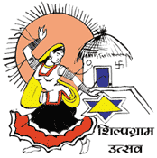West Zone Cultural Centre
 West Zone Cultural Centre (WZCC) is one of the
seven Zonal Cultural Centres set up by the Govt. of India to provide facilities for the
creative development of performing arts, visual arts, traditional folk & tribal art
forms and literary pursuits in the western region of India in the states of Rajasthan,
Gujarat, Maharashtra, Goa and union territories of Daman, Diu & Dadra Nagar Haveli. West Zone Cultural Centre (WZCC) is one of the
seven Zonal Cultural Centres set up by the Govt. of India to provide facilities for the
creative development of performing arts, visual arts, traditional folk & tribal art
forms and literary pursuits in the western region of India in the states of Rajasthan,
Gujarat, Maharashtra, Goa and union territories of Daman, Diu & Dadra Nagar Haveli.
The main thrust of the Zonal Cultural
Centres is to network and disseminate cultural activities in rural India and build up
linkages among various folk art forms at village, district, state level, inter and
intra-zonal level among the member states in association with the various art academies of
state and Central Govt. There is a special emphasis on artists' creativity, peoples'
participation and revival of vanishing arts & crafts.
|
Bagore ki Haveli - Situated on the picturesque bank of Picchola
Lake, This Haveli was built by Shri Amarchand Badwa, who was the Prime Minister of
Mewar-the rulers of Mewar Pratap Singh, Maharana Ari Singh, Maharana Hamir Singh during the
period 1751 to 1778. This palatial building reportedly has 138 rooms, balconies, terraces,
courtyards and corridors. The glass and mirror inlay within the Haveli is Unique and
procured in its original form. The two peacocks made with small pieces of colored glasses
are unique reflection of the finest craftsmanship of glass work. What was once upon a time
a living centre of nobility of Udaipur lay in darkness and ruin for nearly half a century
till when it was handed over to the West Zone Cultural Centre (WZCC) in 1986.
Right from the beginning, the WZCC thought it appropriate to convert the Haveli into a
museum. Originally the idea was to represent the culture of Maharashtra, Goa, Gujarat and
Rajasthan, the West Zone States, in the proposed museum. On second thoughts it was felt
that the Haveli had a very typical and charming architectural style and a unique character
- it was a veritable architectural museum by itself- and therefore it would not be
appropriate to bring into it features of Goan or Maharashtrian culture which would be
ill-at-ease in an unrelated environment like the Haveli.
It was then decided in 1992,
that the Haveli should be restored and preserved as a museum of Mewar's aristocratic
culture as it may be imagined to have existed in the 18th and 19th centuries. The idea was
not to realistically reconstruct the past, but to symbolically invoke the spirit of the
bygone culture by means of a few selected objects displayed in a context that would defy
the conventional notion of a museum and also save itself from the arduous task of
artificial reconstruction of history under the name of 'authenticity'.
A few rooms and passages have been brought to a kind of imaginary lived-in condition of
the Haveli, as it were, in its heyday, by a display of floor-coverings, low tables,
Hookahs, paan-boxes, nut crackers, hand-fans, rosewater sprinklers and several such
household objects of everyday life. A conscious attempt has been made here to avoid a
romantic reconstruction of the culture that was. It is essentially a museum which tries to
re-interpret architecture, life-style and the cultural ethos of days of yore from the
vantage point of the present.
Currently a few spaces such as the women's' private chambers, a dressingroom, a shrine for
domestic worship, a bathroom and a recreation room have been restored and displayed.
Picture Gallery of Shilpgram Festival 2010 |
